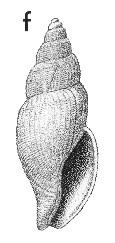
Revised descriptions of New Zealand Cenozoic Mollusca from Beu and Maxwell (1990)

 | Revised descriptions of New Zealand Cenozoic Mollusca from Beu and Maxwell (1990) | 
|
  (Pl. 49f): Kai Iwi siltstone beds, Castlecliff coastal section, Wanganui, Castlecliffian (GNS, early collection) |
Beu & Maxwell (1990): Chapter 16; p. 364; pl. 49 f.
Synonymy: Bela striata Hutton 1873b, p. 5; Siphonalia(?) cingulata Hutton 1885b, p. 315; Daphnella striata; Mitromorpha striata
Type species of Iredalula Finlay, 1926
Classification: Colubrariidae?
Description: Small for family (20-28 mm high), tall and narrow, with weak, rounded shoulder angle high on whorls that are otherwise very gently and evenly inflated; spire slightly taller than aperture and canal; last whorl long, very gently contracted to wide neck and short, widely open anterior canal with low, rounded, poorly defined fasciole. Sculpture of many very fine, closely spaced spiral threads, crossed by extremely fine axial ridges. Aperture long and narrow; outer lip sinuous, with shallow sinus over upper half, weakly thickened; inner lip smooth, weakly thickened. Protoconch relatively large, dome-shaped, of about 1.8 spirally lirate whorls, with a slightly immersed apex, merging imperceptibly into teleoconch.
Comparison: The Mangapanian-Recent Iredalula alticincta (with which I. venusta Powell intergrades) is a rare fossil, but is the Recent species replacing I. striata around the northeastern North Island at present; it differs from I. striata in its much more prominent spiral sculpture. Beu (2009) studied the variation and occurrences of Iredalula species and recognised I. striata as a restricted Wanganui Castlecliffian species (although a few specimens from Kapitean-Opoitian rocks in Westland are probably conspecific). Specimens from Hawke's Bay Nukumaruan rocks and from Castlecliffian rocks at Ohope Beach, Whakatane (in NMNZ) consistently have fewer, more prominent spiral cords than I. striata and agree with the finely sculptured end-members of the population of I. alticincta. The relationships of this genus have long been in doubt, most early authors referring it to the Turridae; Beu & Maxwell (1987) showed that it is related to Metula H. & A. Adams, 1853 and Colubraria Schumacher, 1817, and so probably belongs in the Colubrariidae.
Distribution: Castlecliffian, oxygen isotope stages 25-11 only (possibly also in Kapitean-Opoitian, Westland); "Wanganui (U); Shakespeare Cliff", type of Bela striata, i.e., late Castlecliffian strata at Castlecliff and at Shakespeare Cliff, in Wanganui city (probably from Shakespeare Cliff Siltstone, where the species is most common), Castlecliffian; "Wanganui", i.e., type Castlecliffian section at Castlecliff, Castlecliffian, type of Siphonalia(?) cingulata. Common in offshore siltstone facies at Castlecliff, Wanganui, Castlecliffian, notably the Kai-Iwi siltstone beds and Shakespeare Cliff Siltstone.
Cite this publication as: "A.G. Beu and J.I. Raine (2009). Revised
descriptions of New Zealand Cenozoic Mollusca from Beu and Maxwell (1990). GNS
Science miscellaneous series no. 27."
© GNS Science, 2009
ISBN
978-0-478-19705-1
ISSN 1177-2441
(Included with a PDF facsimile file
copy of New Zealand Geological Survey Paleontological Bulletin 58 in CD version
from: Publications Officer, GNS Science, P.O. Box 30368 Lower Hutt, New
Zealand)